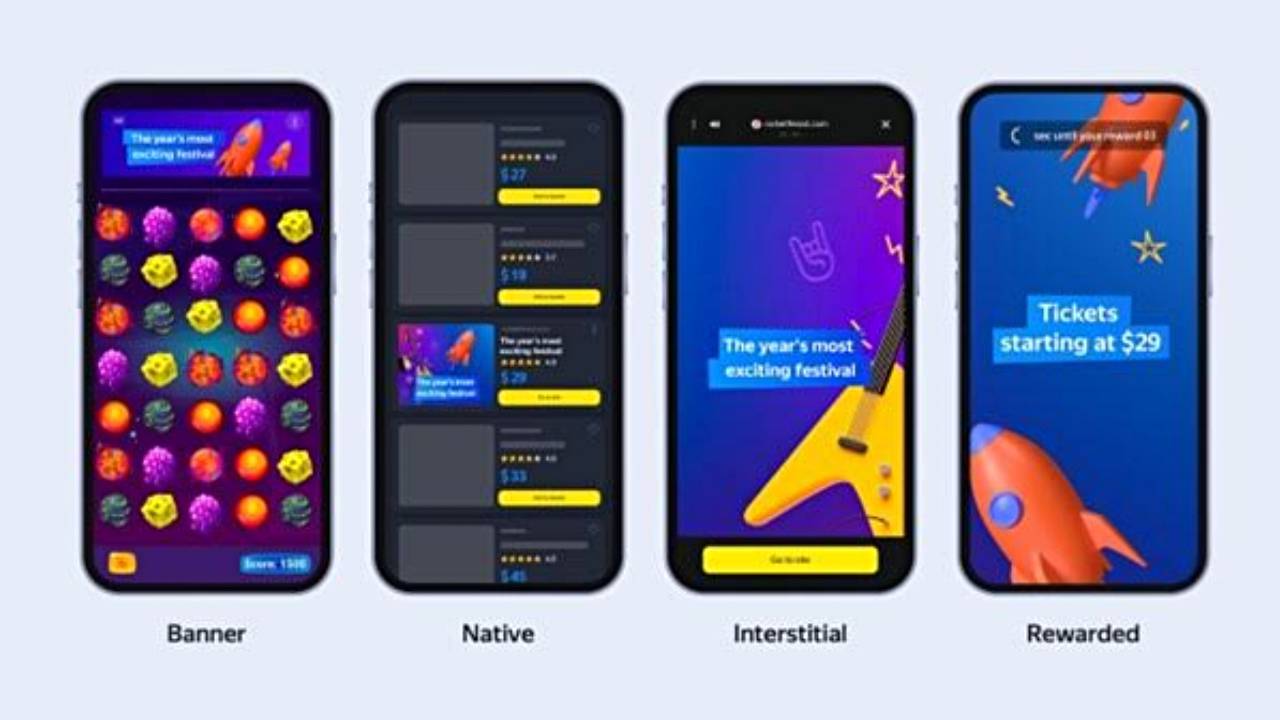According to research, the mobile application market will generate 613 billion dollars for its stakeholders in 20251. And every company wants to get its share of this pie, a significant part of which comes from mobile advertising. We talked to YandexAds Easy Monetization Business Development Manager Elizabeth Olubowale about how mobile application developers can benefit from this opportunity.
Emphasizing that there are many ways to make money from mobile applications, Olubowale states that the most popular among them are paid downloads, in-app purchases and advertisements. “Global data and business intelligence platform Statista 2 estimates that in July 2023, 3 percent of apps worldwide were monetized through paid installs and 4 percent were monetized through in-app purchases,” Olubowale said.
At the same time, among all monetization methods, advertising revenue remains the leader by a large margin, being used by 35 percent of companies developing applications.” Underlining that the requirement to view ads can be seen by users as a more acceptable alternative to having to pay, Elizabeth Olubowale said: “This greatly simplifies the task of attracting customers and reduces marketing costs per installation.

“In addition, advertising revenues may be quite sufficient to meet the financial needs of the company and generate tangible profits,” he said. Olubowale lists the factors on which the effectiveness of in-app advertising may depend as follows:
Choose where to display the ad within the app
The two basic requirements that must be met when choosing where to display ads in an app are pretty simple and intuitive: “Ads must make money but not negatively impact the user experience.”
To achieve the best results, it is necessary to clearly understand how users interact with the application. For example; Ads should be placed where the user is least likely to touch incorrectly. Accidental clicks on advertising pages cause great dissatisfaction and can lead to negative comments in the application store.
- Choose a location where the user will spend at least 3 seconds to place the ad unit. This can be determined by session length in analytics services such as AppMetrica.
- Adjust the frequency of your ads so they don’t appear too many times. For example, you should not place full-screen ads more than every two or three views. This will increase the user’s time on the app and therefore your revenue in the near future.
- Choose a location where the app interface does not overlap the ad space, otherwise the impression will not be counted. If the connection is poor or loading times are slow, make sure your ads don’t block or displace UI elements.

Choosing the ad format
Elizabeth Olubowale notes that the selection of appropriate ad formats largely depends on the features of the application interface and user interaction scenarios. Stating that each of these formats has its own characteristics that need to be taken into consideration, Olubowale gives examples of the main banner formats that use the Yandex Advertising Network:
- Adaptive sticky and inline banners- A small ad located at the bottom or top of the interface that can automatically adapt to the screen size and always takes up only 15 percent of its space. The advantage of this format is that it attracts attention without obstructing the main content of the application and is often used especially in games. An inline banner takes up more space than a sticky banner and works best in applications whose interface is based on a scrollable banner.
- Native advertising- Banners of this type always look like a standard element of the application interface. This could be a post designed the same way as everything else in the feed, for example. Native ads, news platforms, social networks, etc. It is most suitable for applications. To use this format, ads must be adapted manually or a custom formatting template must be created on the SDK side.
- Interstitial- This banner also covers the entire screen, so it is suitable to use when the user has a natural pause between actions. For example, they may be shown moving from one level to the next, or as they complete another target action and prepare to turn their attention to the next.
- Rewarded advertising – It is a full-screen advertising format that the user personally watches in exchange for certain bonuses within the application. Extra lives or points motivate the user to watch, so showing ads does not create any negative effects. This makes rewarded advertising one of the most popular and profitable forms of advertising.
By combining and testing different ad format combinations, publishers can quickly find the optimal banner placement scheme and generate maximum revenue. With these methods, for example, Marul Games 3 increased the cost per thousand impressions by 15-40 percent among Russian-speaking audiences.
The developer used 3 ad formats: banner, rewarded ad and full-screen banner ads. To achieve this result, publishers also regularly conducted A/B tests, worked with the waterfall method, and updated the SDK and ads.txt files.
Add ad units
The first step to making money is to sign up for an advertising platform that works with a preferred app store. After entering all the necessary data, including financial details, the publisher can proceed to add ad units in the selected formats.
The steps for this process may vary depending on the app store, but in all cases, publishers must provide the ad platform with access to the mobile app and undergo verification before ads run. After that, they can continue creating ad units and integrating them into the app.
It’s also a good idea to connect to multiple ad networks at once to get maximum revenue from ads in the app. There is special intermediary software to easily monitor the rates offered by many advertising networks. To use this software, the application settings must be adjusted to meet the requirements of each network, paperwork must be completed with each, and the earned money must be withdrawn from each network separately.
When applying to the broker software, the publisher:
- Chooses which mobile mediation to use;
- Determines which ad networks will connect to the app;
- Signs up for all ad networks;
- Configures ad units for all ad networks;
- Defines and configures thresholds for the agent system;
- Monitors productivity and changes settings accordingly;
- Conducts A/B tests and experiments to increase monetization effectiveness;
- Waits for each ad network to reach a minimum payout threshold
But it is not necessary to set up everything yourself and connect internal resources to start making money from advertising: this can be a rather labor-intensive task and will require certain skills. Instead, publishers can hire experts to set up the revenue stream so the app can start monetizing ads immediately, while the app team can focus on product development.
Easy Monetization from Yandex is the YandexAds service based on AI technologies used in Yandex Mobile Brokerage, which allows application developers to delegate all the setup and work related to monetization to a team of service specialists. Yandex Easy Monetization,
- Analyzes an app and selects the most effective and profitable monetization method based on the geography of its users
- Sets up every monetization feature for you and connects it to a single agent system
- Provides simple instructions for integration and correct installation
- Optimizes ad waterfalls, looks for areas of growth – for example, suggests new formats.
- Provides access to a single account;
- Arranges pricing in a single payment;
Here, experts can most accurately choose the most appropriate configuration that provides access to advertising networks for different countries and regions, depending on the target audience of the application. In addition, since they work with a certain percentage of the publisher’s income, they take this issue seriously as the more the app earns, the more their income will increase.
This service allows small teams to find solutions to revenue problems without investing in large internal resources, while allowing larger teams to increase the efficiency of their existing configurations and rise to a new level of earnings when entering new markets.














